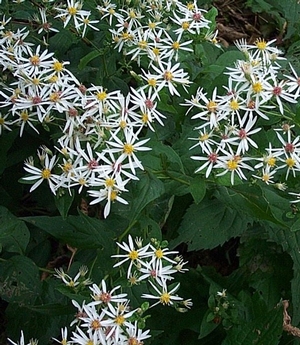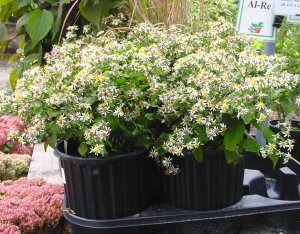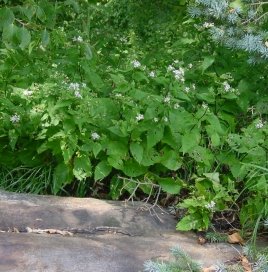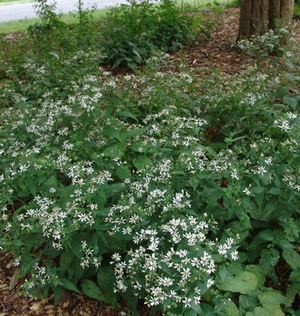Aster divaricatus
Common: white wood asterAster divaricatus LP50 - 50 per flat
- Height: 2'-3'
- Spread: 2'-4'
- Spacing: 12"
- Hardiness Zone(s): 3-8


Aster divaricatus LP50 - 50 per flat



Produces a fairyland of glistening small white daisies in September and October. Lovely when naturalized in shade and average to dry soil. Found in deciduous woods and along roadsides of the Eastern US.
Grow in part to full shade in average to dry soil.
Aster divaricatus, now Eurybia divaricata, is among the first asters to bloom in late summer. Covered in small, white, simple daisy-like flowers with golden centers that fade to a dusky rose, it is held up zigzag dark green and black stems. The heart-shaped foliage grows about 2 feet tall and spreads rhizomotously or by seed through the shade garden. It is a wonderful groundcover that interweaves beautifully among other shade growers in a woodland edge or cottage garden and provides much-needed late season bloom.
White wood aster hails from the woodlands following the Appalachian mountain range, tolerating a wide range of soil types and handles dappled shade to full shade in dry to moist soils. The plant generally has very little pest and disease issues, including deer pressure. However, to ensure best resistance to powdery mildew, plant it in an area with some air movement and soil drainage.
Eurybia divaricata was renamed in the turn of the 21st century after genetic testing showed the Eurasian Aster to be less related to its North American counterpart – spinning off a division of ten new genera from Asteraceae. We find this plant to be great anywhere we place it including our wild woodland edge and under deep shade near a blue spruce. White wood aster is a great filler in any project that requires a broad stroke that can tolerate a variety of challenging conditions including dry shade.
Aster divaricatus provides excellent late summer season nectar resources for beetles and Lepidoptera species and provide valuable habitat in its foliage for their larval stage.